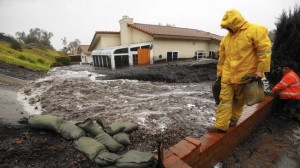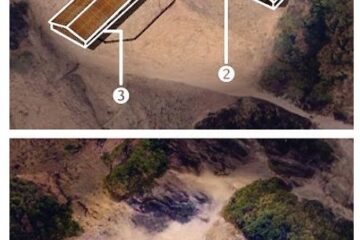Storm drenches California, but it’s only a drop in state’s drought
California’s heavy rains bring some evacuations but have little effect on the state’s continuing drought
Source of this article: The Los Angeles Times, December 2, 2014
The first major Pacific storm of the season drenched much of California on Tuesday, slaking a parched and dusty region, but still leaving the state deep in a historic drought.
The stream of subtropical moisture dropped more than an inch of rain over much of Los Angeles County by evening, with higher numbers in the local mountains. In foothills and canyons where fires recently burned desiccated brush, residents scrambled to set up barricades to divert debris flows and prepared to evacuate.

Danny Lopez, left, and Fernando Hacindo work to stem mud and debris flowing down a blocked drain in Camarillo Springs.
In Camarillo, gushing mud and water prompted a mandatory evacuation of 75 homes where a slide had buried a residence on Halloween. In Glendora and Azusa, homeowners and fire crews worked feverishly to buttress sandbags with plywood and concrete blocks. Rock slides hit the road in Malibu Canyon, and in Silverado Canyon residents moved horses and other large livestock to lower, flatter terrain.
The rain was expected to taper off during the night, with another band of moisture arriving in the morning.
But fears of nature’s destructive power were tempered by optimism.
The storm gave state water officials the first glimmer of hope in more than a year; on Monday they increased 2015 water allocations in response to improving precipitation forecasts.
Lake Oroville — the keystone reservoir of the California State Water Project, which delivers water from Northern California south — took in 5 billion gallons over the last 10 days, officials said. Still, that is less than 1% of its capacity.
State water experts said it would take 150% of the average rainfall for California to recover from the current drought. That would mean a total of 75 inches of rain from Oct. 1, 2014, through Sept. 30, 2015, recorded at eight stations in the northern Sierra.
“Even if you had a tremendous downpour this weekend, who knows what’s going to happen in the next two months,” said Doug Carlson, spokesman for the California Department of Water Resources. “We certainly hope that the rainfall we have now pushes us toward normal — but we’re still below normal.… We’re just trying to get to average.”
For residents of Southern California, the storm provided a break from a monotonous, seemingly endless span of sunny days. Children splashed in puddles, pedestrians huddled under awnings and bus stops, and gawkers gathered to see the Los Angeles River — normally a trickle — come to a dangerous roar.
The homeless on skid row struggled to stay dry, standing in doorways and crouching under blankets. The better-appointed zipped up their tents, while others made shelters with tarps, grocery carts and wheelchairs.
Under an awning near the Union Rescue Mission, Oliver Svenson, 62, from Denmark, sat in a blue walker with a clear plastic bag over his knees. He came outside Tuesday afternoon to get some fresh air.
“I’m enjoying the rain — I like the four seasons,” he said. “I’m getting into meditation and looking for a new perspective.”
In the San Gabriel foothills below the area burned in January by the Colby fire, the perspective was anything but new: keep the mud away from homes.
More than 18,000 sandbags were distributed in Glendora in anticipation of the storm, in addition to the 50,000 given out earlier in the year.
Los Angeles County firefighters came Monday night to put sandbags around Ed Heinlein’s home on Ridge View Drive in Azusa. Heinlein, 66, darted around his property Tuesday, reinforcing a plywood barricade with wire.
In March, less than two months after the fire, 2,500 tons of mud broke through the steel fence meant to stop it, plowing into his home, he said. The house was red-tagged and the family spent the last eight months cleaning up the mess. Then on Halloween night, a relatively minor storm delivered three feet of mud to his backyard.
He put in a new $20,000 steel fence three weeks ago, but still feared what would come in a microburst.
Glendora suffered a massive debris flow in 1969 that destroyed 30 homes.
“Now they claim it’s all coming back,” said Heinlein, 66. “If we get three inches of rain we’ll get a 10-foot mud flow.”
His neighbor David Jones, 58, moved his cars down the hill and put the family’s valuables upstairs.
“This is life up here,” Jones said. “As long as everyone is walking at the end of the day, the houses and all that stuff can be rebuilt.”
Jones said he has no plans to leave, despite voluntary evacuation advisories.
“I’ve been up here this long, I’m not going to bail now. It’s part of life.”
By evening, water was streaming down the gullies and into the street, but no mud.
By 6 p.m, the mandatory evacuation was lifted in Camarillo, and some people were starting to count their blessings.




0 Comments